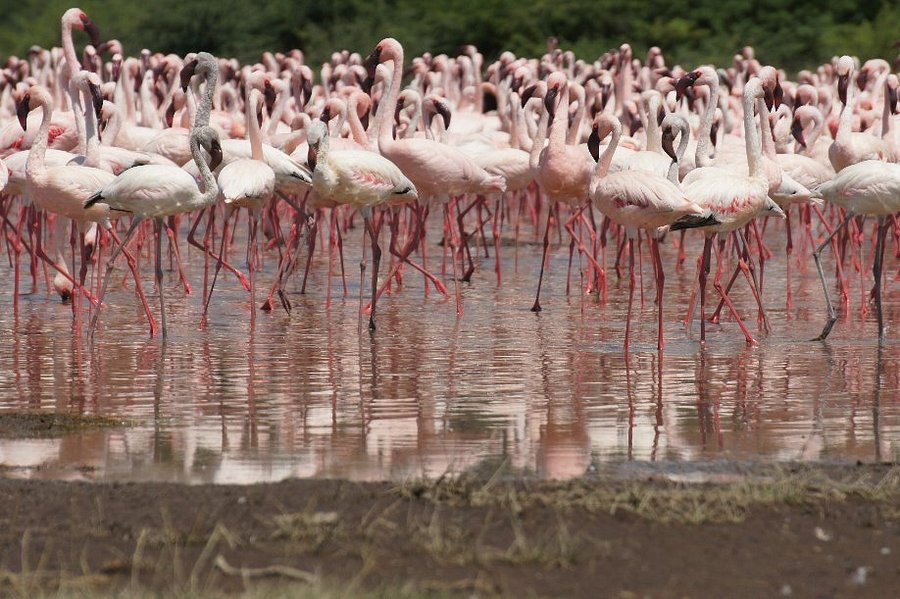Lake Bogoria National Reserve
Lake Bogoria National Reserve is a hidden gem located in the Great Rift Valley of Kenya. Established in 1973, this reserve covers approximately 107 square kilometers (41 square miles) and is renowned for its stunning landscapes and unique ecosystems. The reserve is centered around Lake Bogoria, a saline, alkaline lake that is famous for its geothermal features, such as hot springs and geysers.

The surrounding area is characterized by rugged terrain, with dramatic hills and escarpments providing a picturesque backdrop for wildlife and visitors alike. Lake Bogoria is also an essential habitat for various bird species, making it a prime destination for birdwatching enthusiasts.
Wildlife In Lake Bogoria National Reserve
The wildlife in Lake Bogoria National Reserve is diverse, with a variety of mammals and reptiles inhabiting the area. Visitors can expect to see herds of waterbucks, buffalo, and impalas roaming the grasslands. The reserve is also home to the greater kudu, a striking antelope known for its impressive spiral horns. While larger predators such as lions and leopards are less common, sightings do occur occasionally. The hot springs and geothermal activity in the area create a unique ecosystem that supports various smaller mammals and reptiles. The reserve is also a haven for the endangered African painted wolf (wild dog), which can sometimes be spotted in the area.
What Is Lake Bogoria Famous For?
Lake Bogoria National Reserve is famous for its breathtaking scenery and natural beauty. The shimmering waters of the lake, set against the backdrop of the Rift Valley escarpment, create a stunning visual experience. The reserve is particularly renowned for its geothermal features, including the numerous hot springs that dot the landscape. These springs not only provide warmth to the surrounding environment but also attract wildlife and visitors alike. The surrounding hills and plains offer spectacular viewpoints, allowing visitors to take in the expansive views of the lake and its surroundings. The stunning sunrises and sunsets over Lake Bogoria are a photographer’s dream, making it a popular spot for both amateur and professional photographers.
Birds in Lake Bogoria?
Lake Bogoria is a birdwatcher’s paradise, with over 300 bird species recorded in the reserve. The lake is particularly famous for its large population of greater flamingos and lesser flamingos, which flock to the saline waters to feed on the abundant algae. The sight of thousands of flamingos wading in the shallow waters is a breathtaking spectacle and a highlight for many visitors. Other notable bird species in the reserve include the African fish eagle, white-breasted cormorant, and Egyptian goose. The diversity of habitats within the reserve, including wetlands, grasslands, and acacia woodlands, supports a rich variety of avian life, making it an ideal destination for birding enthusiasts.
Weather and Climate
Lake Bogoria National Reserve experiences a semi-arid climate, with distinct wet and dry seasons. The wet season occurs from March to May and October to December, bringing an average rainfall of about 500 to 1,000 mm (20 to 39 inches) per year. During these months, the landscape becomes lush and vibrant, with flora blooming in response to the rains. The dry season, which lasts from June to September and January to February, features warmer temperatures ranging from 20°C to 30°C (68°F to 86°F) during the day. Nights can be cooler, dropping to around 10°C (50°F). The best time to visit Lake Bogoria for wildlife viewing and birdwatching is during the dry months when animals congregate around water sources and the flamingo populations are at their peak.
Getting To Lake Bogoria National Reserve
Lake Bogoria National Reserve is located approximately 250 kilometers (155 miles) northwest of Nairobi. The reserve is accessible by road, with a drive from Nairobi typically taking around 4 to 5 hours. Travelers can take the A104 highway towards Nakuru and then follow the signs to Lake Bogoria. For those who prefer a quicker option, domestic flights are available to nearby airstrips, such as Nakuru Airstrip, followed by a short drive to the reserve. Once inside the reserve, visitors can easily navigate the area with the help of local guides and park rangers.
Activities to Engage in Lake Bogoria national Reserve
Lake Bogoria National Reserve offers a range of activities for visitors to enjoy, enhancing their experience in this stunning natural setting:
Game Drives: Guided game drives provide an excellent opportunity to spot wildlife in their natural habitats, particularly during the cooler hours of the day.
Birdwatching: With its rich avian diversity, birdwatching is a popular activity at Lake Bogoria, allowing enthusiasts to observe both resident and migratory bird species.
Hot Springs Visits: Explore the geothermal features of the reserve, including the hot springs, where visitors can witness bubbling waters and steaming vents.
Photography: Capture the breathtaking landscapes and unique wildlife, particularly the impressive sight of flamingos against the backdrop of the lake.
Nature Walks: Take guided nature walks to explore the reserve’s flora and fauna up close, gaining insights into the local ecosystem from knowledgeable guides.
Cultural Experiences: Engage with local communities to learn about their culture, traditions, and conservation efforts, adding a deeper dimension to your visit.
Fishing: For those interested, fishing opportunities are available on the lake, offering a chance to relax and enjoy the serene environment.
Safety and Vaccination
While Lake Bogoria National Reserve is generally safe for visitors, it’s essential to take standard safety precautions when traveling in Kenya. It’s advisable to travel with a reputable tour operator or guide familiar with the area to enhance your safety and provide insights into the local environment. Before traveling to Kenya, visitors should consult with their healthcare providers regarding vaccinations. Recommended vaccines include yellow fever, hepatitis A, and typhoid. Although malaria risk is lower in the Lake Bogoria area due to its altitude, it’s wise to take preventive measures, such as using insect repellent and sleeping under mosquito nets, especially if traveling to lower-lying regions.
Park Rules For Lake Bogoria National Reserve
Visitors to Lake Bogoria National Reserve are required to follow specific rules to help protect the park’s natural environment and wildlife. It is essential to stay on designated paths and trails to minimize ecological impact. Littering is strictly prohibited, and all waste should be disposed of properly to keep the reserve clean. Approaching or feeding wildlife is not allowed, as it can disrupt their natural behaviors and lead to dangerous encounters. Noise levels should be kept to a minimum to maintain the tranquility of the area. By adhering to these guidelines, visitors can help preserve the unique ecosystem of Lake Bogoria for future generations.
